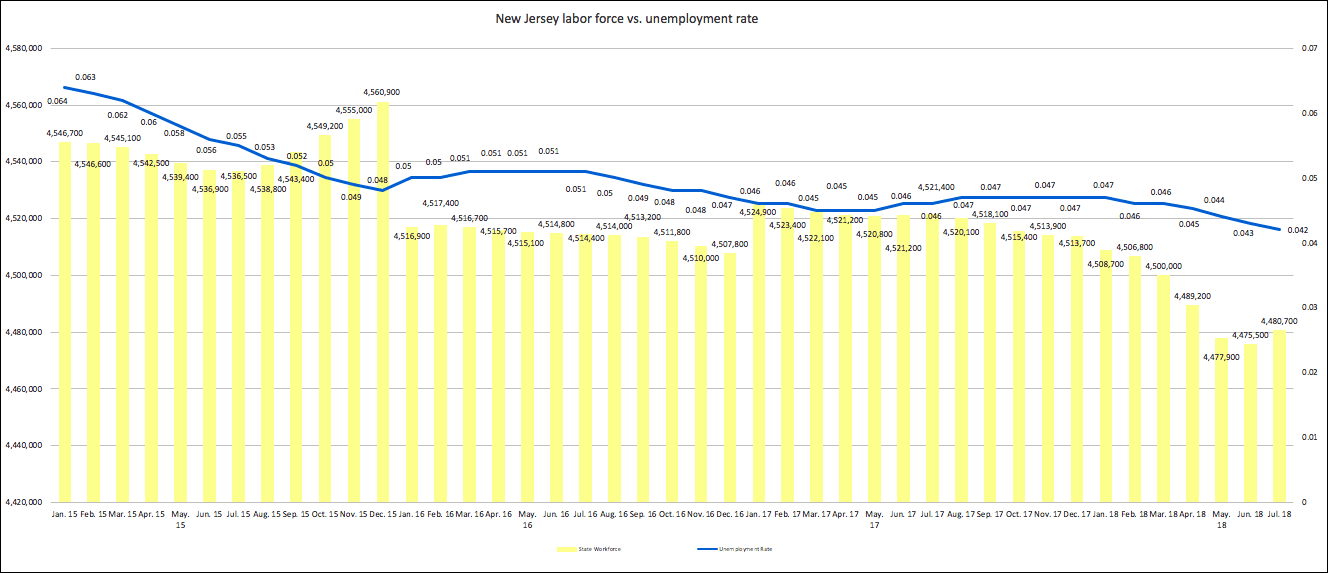Unemployment, TRANSFORMING OUR BUSINESS CLIMATE, Labor
GSI Analysis: July ’18 – July Marks First Positive Jobs Numbers of 2018

July’s jobs report for New Jersey showed some positive short term developments in the state’s economy. However, over the longer term, July marked only the first positive month for many economic figures this year.
According to the household jobs survey released today by the U.S. Bureau of Labor Statistics (BLS), New Jersey’s labor force grew by 5,200 residents over the month. This marks the first positive growth for the state’s workforce population since January 2018. More residents reporting being employed in July and less residents reporting being unemployed. Both positive trends from last month.
However, July’s workforce numbers are still much lower than the state’s labor force in July 2017. New Jersey has 40,700 fewer residents in its labor force as compared to the same time last year. That means that fewer people are either employed or actively looking for work in New Jersey.
In their announcement for this month’s jobs report, the New Jersey Department of Labor and Workforce Development touted how the July unemployment rate of 4.2 percent marks the lowest unemployment rate for the state since July 2007. The unemployment rate is determined by dividing the number of unemployed people by the number of people in the total labor force. However, despite the over-the-month gains, the state’s shrinking labor force as compared to a year ago—or three years ago—shows the danger of relying solely on a state’s unemployment rate as an accurate metric for economic growth.
The following graph shows New Jersey’s unemployment rate as it relates to the state’s workforce levels.
According to the Business Establishment survey also released today by the BLS, New Jersey private sector employers added 13,200 jobs in July. Since July 2017, New Jersey private sector businesses have added 73,400 jobs to their payrolls (this number does not include public sector jobs which are often times more influenced by political initiatives and public sector union contracts than the state’s economic standing).
While both of July’s economic reports for New Jersey showed positive growth over the month, cautious optimism is likely the healthiest response in terms of the state’s long-term economic outlook. Before this month, New Jersey’s economy had suffered five months in a row of a shrinking workforce.
A shrinking workforce means that people are either leaving the state or fewer people in the state are working or looking for work. While it’s difficult to determine with the data whether people leave the workforce for financial or personal reasons, a continually shrinking workforce is more likely caused by deeper state policy issues than a sudden surge of retirees or snowbirds.
The two sectors to add the most jobs in July were Education and Health Services with 4,700 new jobs and the Leisure and Hospitality sector which added 7,000 jobs (the state announced that the spike of hospitality sector jobs was due to the June opening of two casino hotels). The construction sector suffered the biggest job loss with 1,000 jobs being lost from June to July.
While the manufacturing sector added 1,600 jobs in July, many New Jersey manufacturers recently voiced their concern about the direction of New Jersey’s economy in light of recent state and federal policy changes. Manufacturers discussed how new Federal tariffs along with many of New Jersey’s economic policies have made it increasingly difficult to compete or even survive in the Garden State.
These manufacturers echoed what recent research from the nonpartisan Garden State Initiative revealed about how New Jersey’s high taxes across the board, along with uncompetitive economic policies—especially those enacted in the most recent state budget—have put the Garden State behind comparable states such as Massachusetts and Indiana.
The state’s monthly jobs report is made up of two separate survey’s that, while related, measure different sets of data.
The Business Establishment survey is conducted by BLS contacting approximately 4,000 businesses in the state and gathering data on their payroll job levels.
The Household survey is conducted by BLS in conjunction with the U.S. Census Bureau who contacts a sample of New Jersey residents to gather data on whether they are currently employed, actively looking for work, or not employed and not looking for work. The unemployment rate and labor force is calculated from the household survey, not the business survey.
Both surveys are revised each month to account for any added detail from the previous month’s report. New Jersey’s June household survey was revised this month to add 300 residents to the state’s workforce for that month. The business survey for June was adjusted higher with an increase of 8,000 jobs.

